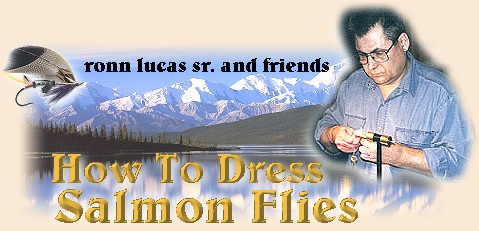|
Marc Madore is a particularly talented Fly Fisher and
Tyer. He is inquisitive and creative and, ties not only
beautifully crafted fishing flies, he also ties fantastic
display flies including the fully dressed Atlantic Salmon
Flies. Marc is involved with many facets of our sport/hobby
and is well respected by his peers far and wide.
This series of patterns are some of Marc Madore's inspired
design. I thought about how to present these, should I just
offer them one at a time with its recipe or, give them their
own section as they really deserve. I opted for the latter.
So, what follows is their story as told by Marc Madore.
"Hello Ronn,
Enclosed are a few flies that might be dressed differently
and of interest to your readers. They work the very best as
we say on the Miramichi and, can be dressed for all fishing
conditions. As for colour combinations, one is only limited
to one's imagination.
The River Shrimps, here are some of the principals that I follow:
1. Tails should be no longer than the full length of the
shank plus ¼" and, no longer.
2. Use UNI-Mylar pearl tinsel 1/16" (no. 10). I've used
other sizes but they don't fully cover the top as I would
like and other materials did not seem to perform as well,
caught less fish.
3. For the front part of the body, I like to use Peacock
herl. I'm sure other materials would also work well. The
proportions used, rear 3/5 dubbing, front 2/5 herl.
4. The tail materials should fit fishing conditions. Example,
slow water can be soft but medium fast-to-fast water use a
stiffer material. I sometimes use stripped quill, these can
break though, and sometimes stiff Moose is ok. The best
I've found for stiffness and durability is Chinese Boar.
Certainly, there are others. If found, this information
should be disseminated to all concerned because of its
importance. When I used soft tails in fast water, the
tail was following behind the fly and not giving action
to the fly. Now, you can fish these flies with a short
tail; have done this many times with success. I have
enclosed one (see, River Shrimp, Brown, Short Tail), but
if one expects the tail to react to the currents, then
one should think of my remarks.
5. For the collar and head position, I use mostly hen
which works well. When fishing with a riffling hitch,
I position the head further back to allow for two hitches
so not to crowd the hook eye. I've seen some anglers put
the hitch over the collar thus removing some of the fly's
character and action.
6. For those who would like to sink this fly even more,
the use of a cone head works well. During the Salmon season
we can't use this weighted method as there is no weight
allowed on our Salmon Rivers.
The original fly that started my frustrations with
friends that wanted me to teach them how to dress the General
Practitioner. Some of them had a difficult time with this
simple fly, so after awhile, I told them I would design
something similar in the hope they could master it and be
effective too.
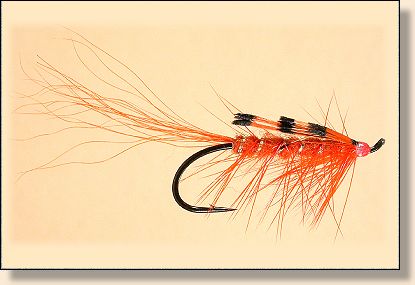
Recipe Original River Shrimp
Hook: Partridge Single Wilson, or Daiichi 2131, Bob Veverka's
"classic Salmon hook" #4 to #10.
Thread: UNI-thread fire orange 8/0.
Tail: Orange bucktail, long & sparse.
Body: Orange Seal dubbing or substitute.
Rib: UNI-Tinsel oval silver, medium.
Hackle: Orange palmered from second rib.
Wing: Three pairs of Golden Pheasant tippets lacquered.
Head: Orange.
So came the orange one and it did have only orange for the
complete body. That changed shortly after to the two part
body. Again, the darned thing caught fish! Using a two-part
body would give me more options so, came the different colours
we found over the years to be attractive to Salmon in waters.
The colouration of the waters changes quite a lot depending on
where you fish and what river you're on. Since there are seven
rivers around me, the bottoms of these rivers vary a lot
creating different backgrounds. I started to get fancy with
a feather wing and sometimes adding Jungle Cock and they also
worked. Then it dawned on me as to why I had started this
affair in the first place which, was to produce a simple but
effective fly the locals could produce easily and economically.
I stopped showing this fly around so as not to encourage people
that these fancier versions of the flies were the way to go,
and we had achieved our goal. Then one day I had a bunch of
discarded tying materials on my work table and, being bored
with nothing to do, I picked up a nymph hook and produced a
fly I call a nymph/stonefly whatever.
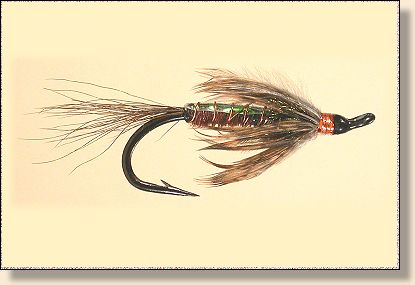
Recipe Ugly Fly
Hook: Partridge Single Wilson, or Daiichi 2131, Bob Veverka's
"classic Salmon hook" #4 to #10.
Thread: UNI-thread black 8/0.
Tail: Fine brown hair.
Body: Pheasant tail rear 3/5, herl front 2/5 topped with
UNI-Mylar pearl tinsel 1/16" (no.10).
Rib: UNI-Wire copper.
Collar: Dark Partridge.
Head: Black with copper tinsel at rear.
Using Partridge feathers and a piece of pearl mylar produced
a terrible looking fly, ugly enough to catch a Trout I thought
and, the darned thing worked! So I dressed the same ugly fly
on a Salmon hook and fished it with success under adverse
conditions. I dressed more and gave them to friends and asked
them to give them a try. Paul Marriner was introduced to that
model only last year (2001), first fish he caught that year
on the Miramichi was with that fly under difficult conditions.
You might wonder why I say difficult. Well, there are many
occasions when the fishing is just great and mostly any fly,
Trout flies included will give you a hook-up. The true measure
for me is when the fishing gets tough, and you have a fly that
you have confidence in and it will in fact do the job for you.
So, I came back to the original pattern and applied the pearl
mylar to it, removed the palmered hackle and, put a collar on
as was the ugly nymph/stonefly pattern had, voila, success,
it worked! I would say that it worked even better than the
original pattern and is very easy to dress.
We have a lot of water that looks sort of tea coloured under
normal conditions and certainly after a rain. The pearl mylar
I would suspect gives the fish a target to strike at. Another
advantage this type of fly has, as do other Shrimp patterns
is that they can and should be fished across and/or slightly
up river thus covering more water than those whom fish at 45
degrees. Not that other flies can't be fished that way, these
however work better while fished in that manner. Keep in mind
that when the current really flows hard, you MUST decrease
the angle of presentation as do those fishing with other types
of flies. This is sometimes forgotten by many anglers.
As there is no magic formula other than a grenade and other
unthinkable methods for catching these fish, other than good
common sense, talking to friends, practice, a good fly for
the type of water you are fishing on and, sportsmanship, one
can always get a fish at the supermarket!
Irish Shrimp-type Flies
The only recommendations I can give to other Tyers not familiar
with these is the method of tying the tail on. If one does not
fold and attach the tail correctly, the fly will not pulsate
properly during the pause phase of the retrieve, loosing the
enormous value of this type of fly. As seen in the example,
the Golden Pheasant red breast feather tail is attached with
the feathers dull side up and ONLY the far side of the feather
is folded thus once wound on leaves the tail opened so it will
breathe and pulsate. The tip is NOT cut; leave it intact giving
it more body and stiffness to the tail. On large flies I
sometimes attach two feathers to give it enough consistency
to be effective with the currents. Keep in mind that the
same principals as the river shrimps that stiffness sometimes
is needed to make the fly function properly.
The tail length is the same as the others. Recently the more
popular body proportions are, rear length = 2/5 and the front
part 3/5. This is exactly the opposite as the river shrimps.
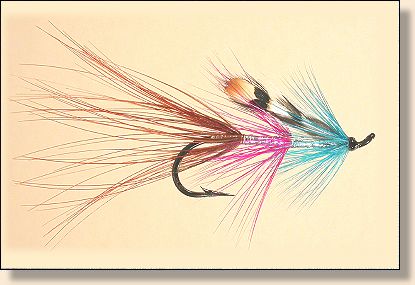
Recipe Silver Wilkinson Shrimp
Irish-type Sprimp
Hook: Partridge Single Wilson, or Daiichi 2131, Bob Veverka's
"classic Salmon hook" #4 to #10.
Thread: UNI-thread black 8/0.
Tag: Flat embossed silver tinsel.
Tail: Golden Pheasant red breast feather.
Body: Rear 1/2 flat silver tinsel, body joint, fuchsia hackle,
font 1/2, flat silver tinsel.
Rib: UNI-Tinsel, oval silver, medium.
Wing: Jungle Cock.
Collar: Blue hackle.
Head: Black.
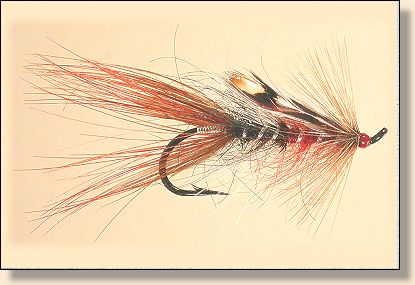
Recipe Foxford Shrimp
Irish-type Sprimp
Hook: Partridge Single Wilson, or Daiichi 2131, Bob Veverka's
"classic Salmon hook" #4 to #10.
Thread: UNI-thread black 8/0.
Tag: Flat embossed silver tinsel.
Tail: Golden Pheasant red breast feather.
Body: Rear 1/2 black Seal or substitute, body joint, silver
badger hackle & black Ostrich, front 1/2, claret Seal or substitute.
Rib: UNI-Tinsel, oval silver, medium.
Wing: Jungle Cock.
Collar: Brown or dark ginger hackle.
Head: Red.
And here is the tailing method:
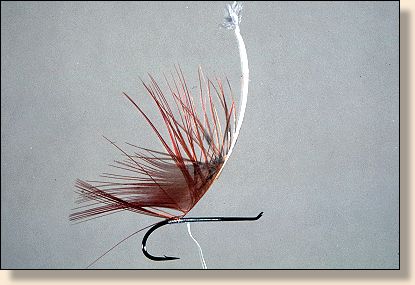
For more of Marc's shrimp flies see the listing under
Shrimp flies.
|
